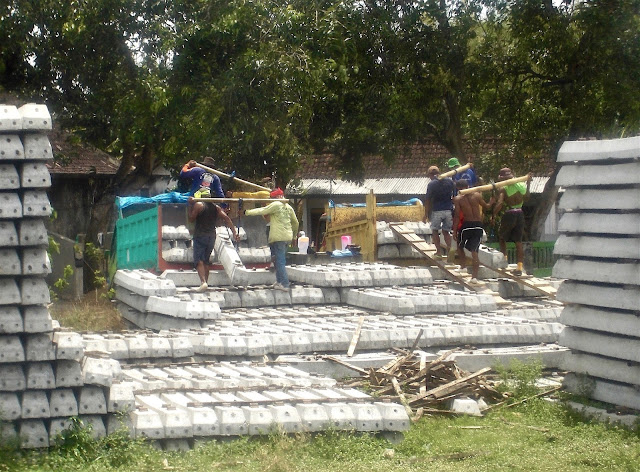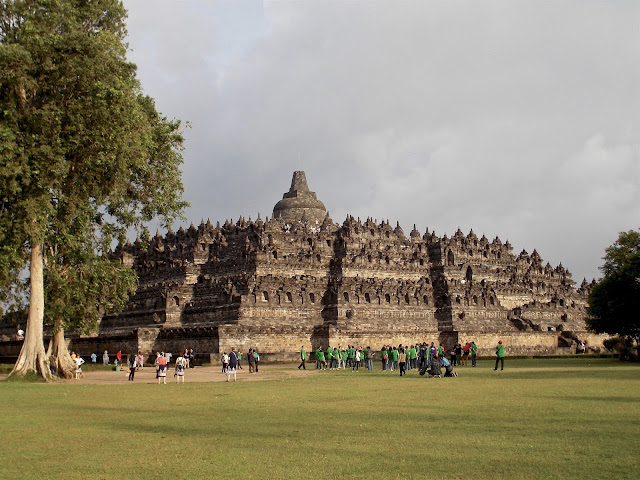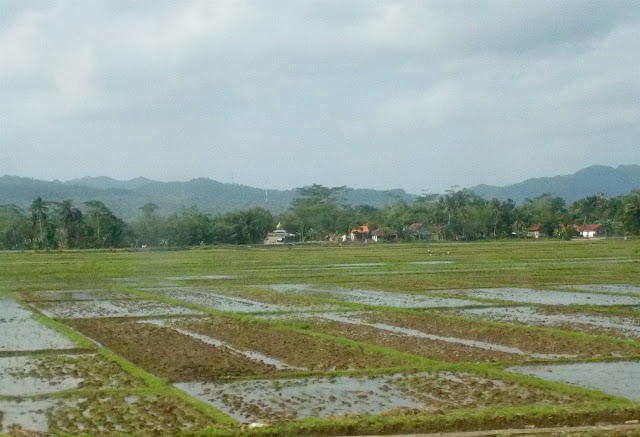Another long train journey took us from Yogyakarta to Malang, a former Dutch colonial city in east Java. We were too late to book Eksecutif class, so this time we travelled Ekonomi class. The seats are actually more comfortable than they look and the carriage was half empty so we had four seats for the two of us. Another advantage was that the windows weren't tinted. That and the slower speed of the train compared to the express from Jakarta meant that photos from the window were sharper and more true in colour.
At every road crossing we saw the usual swarm of motorbikes clustered in the front line.
Outside the towns, the landscape was a dream-come-true tropical paradise, except perhaps for the clouds threatening rain. However, it was only the beginning of the monsoon season, so although showers were intense, they were brief.
Construction was a regular sight.
We were impressed by these workers carrying heavy concrete blocks on their shoulders.
Behind their worksite you can see small homes with clay-tiled roofs. These seemed to be typical of the area around Malang.
Saturday, December 30, 2017
Wednesday, December 27, 2017
INDONESIA - Prambanan
Our second foray from Yogyakarta was to the 9th century Hindu temples at Prambanan. We chose a tour that gave us an afternoon to wander around the site on our own, transport to a local restaurant for dinner and return to Prambanan for an evening dance performance of the Ramayana epic with the floodlit temples as a backdrop.
Although they are not as imposing as Borobudur (see previous post), I preferred them for their elegance and the more sensitive restoration.
There are three principal structures, one each dedicated to the triumvirate of Hindu gods: Brahma the Creator, Vishnu the Preserver and Shiva the Destroyer. Smaller temples surround these three. Like Borobudur, the site was abandoned, plundered and rediscovered. Restoration is ongoing, hampered by the difficulty of locating and reclaiming many of the pieces.

Fewer tourists than at Borobudur made this an easier place to enjoy the unique features and artistry of the temples.
Originally, each candi (individual temple), held images of gods or sacred creatures. Some of these have been restored, including a statue of Ganesha, the monkey god and one of the Trimurti, the three-faced image that represents the three major gods. It's very dark in these niches but fortunately Michael had a small flashlight that gave enough illumination without the harshness of a camera flash.
After our meal in a pleasant and simple little restaurant nearby, we returned at dark to watch the ballet performance on a large concrete stage. Our seats were also concrete, but provided with comfortable cushions. Many people in the cheaper sections, which seemed to be only available to locals, brought their own. Regardless of where you sat, you had a good view of the stage, with the temples looming behind.
The performance was spectacular and well worth the price (around $30 per person for the second-best seats.) Dancers performed in front of a choir and gamelan orchestra
The climax of the drama involved the lighting of huge fires through which Hanuman, the White Monkey King leaped to conquer the wicked magician who had kidnapped the beautiful princess Sita.
The fires were hot enough that we felt the warmth on our faces.
Although they are not as imposing as Borobudur (see previous post), I preferred them for their elegance and the more sensitive restoration.
There are three principal structures, one each dedicated to the triumvirate of Hindu gods: Brahma the Creator, Vishnu the Preserver and Shiva the Destroyer. Smaller temples surround these three. Like Borobudur, the site was abandoned, plundered and rediscovered. Restoration is ongoing, hampered by the difficulty of locating and reclaiming many of the pieces.

Fewer tourists than at Borobudur made this an easier place to enjoy the unique features and artistry of the temples.
I was intrigued by the number of panels depicting monkeys.
... and also by a depiction of a pregnant woman.
The performance was spectacular and well worth the price (around $30 per person for the second-best seats.) Dancers performed in front of a choir and gamelan orchestra
The climax of the drama involved the lighting of huge fires through which Hanuman, the White Monkey King leaped to conquer the wicked magician who had kidnapped the beautiful princess Sita.
The fires were hot enough that we felt the warmth on our faces.
Tuesday, December 26, 2017
INDONESIA - Borobudur
We made a day trip to Borobudur from our base in Yogyakarta (see below). Borobudur, completed in the 9th century, is the world's largest Buddhist temple. Photographs do not convey how vast a structure it is, partly because it is built on a broad flat-topped hill which you have to climb even before you get to its base. From there it looms above the landscape.

Once you start to climb the 9 levels to the top, the height becomes even more impressive.
For years it was buried in the jungle under lava from a nearby volcano.Then, in 1814, during Britain's brief rule over Java, the British governor, Sir Stamford Raffles, heard tales of it and sent a Dutch engineer, H. C. Cornelius, to find and restore it. It is now Java's top travel destination.
The site once held 504 statues of Buddha. Although about 300 have been damaged, either decapitated by thieves or defaced by local fanatics, there are still numerous examples left to see.
Every one of the many stupas (bell-like structures) held a Buddha, although these had suffered the worst damage. It was hard to find one that still had a head.
 The popularity of the site attracts mainly sightseers like ourselves, most of them busy taking selfies.
The popularity of the site attracts mainly sightseers like ourselves, most of them busy taking selfies.
But there are still some devotees among the crowd.
In spite of damage and some clumsy restoration, the bas-reliefs carved into the walls were fascinating.
By the time we left, the late afternoon sun was casting long shadows that silhouetted the stupas against a pale sky.

Once you start to climb the 9 levels to the top, the height becomes even more impressive.
For years it was buried in the jungle under lava from a nearby volcano.Then, in 1814, during Britain's brief rule over Java, the British governor, Sir Stamford Raffles, heard tales of it and sent a Dutch engineer, H. C. Cornelius, to find and restore it. It is now Java's top travel destination.
The site once held 504 statues of Buddha. Although about 300 have been damaged, either decapitated by thieves or defaced by local fanatics, there are still numerous examples left to see.
Every one of the many stupas (bell-like structures) held a Buddha, although these had suffered the worst damage. It was hard to find one that still had a head.
 The popularity of the site attracts mainly sightseers like ourselves, most of them busy taking selfies.
The popularity of the site attracts mainly sightseers like ourselves, most of them busy taking selfies.But there are still some devotees among the crowd.
In spite of damage and some clumsy restoration, the bas-reliefs carved into the walls were fascinating.
By the time we left, the late afternoon sun was casting long shadows that silhouetted the stupas against a pale sky.
Sunday, December 24, 2017
INDONESIA - Yogyakarta
October 11 -15, 2017
The train journey from Jakarta to Yogyakarta in Central Java takes about 8 hours. We had booked Eksecutif class, which was comfortable and, in spite of the crowd on the platform, quite spacious.
Though not by any means a bullet train, it travelled reasonably fast, which made good photos of the scenery through the tinted windows rather difficult. For much of the time it was a lush, green landscape of rice fields and coconut palms interspersed with many small towns, and some larger ones where we stopped to load and unload passengers.
When we arrived, we took a taxi to Duta Gardens Hotel, where we had booked accommodation. It seemed a long way from the station, but we discovered that it was only a short, inexpensive ride in a becak to the places we wanted to go.
The hotel was great: a series of up/down en-suite rooms set around a pool. There were more expensive villas too in a separate garden setting, but we were perfectly happy with the more modest accommodation.
We kept extending our stay and so had the opportunity to try several different suites. My favourite was the final one, which was upstairs with a view over the pool from the spacious veranda. With windows on two sides, it was brighter than the lower ones and had a more private outdoor space.
A simple breakfast of eggs, fruit and toast in the airy, open restaurant was included in the price.
The front desk people were very helpful. Apart from cheerfully accommodating our extensions of more nights, they recommended nearby restaurants and arranged visits to the two major temples in the area, Borobodur (Buddhist) and Prambanan (Hindu) for us, including tickets for a Ramayana Ballet performance at Prambanan (see posts above.)
Unlike Jakarta, Yogyakarta still has numerous becak drivers who will take you anywhere for a small sum. Luckily we're not very wide or we wouldn't have squeezed in. Michael just barely had enough head room. A few drivers still pedal manually, but most now have motorized bikes.
We negotiated a ride to the Sultan's palace, which is a must-see in this city. Yogyakarta is one of the few remaining sultanates in the country, partly due to the sultan at the time of independence becoming a senior member of the new government.
The palace is not a single building, but a series of pavilions separated by leafy courtyards.
Decorations in the pavilions were spectacular, from ornately painted and gilded wood carving


... to beautiful stained glass.
One pavilion housed a gamelan orchestra, although no-one was playing the polished brass gongs when we were there.
There was, however, ongoing musical activity, mostly individuals or small groups singing or reciting.
While the woman above was intoning some verses, other performers in traditional dress quietly waited their turn just outside.
Later, in a small courtyard, we came across some men who were adjusting the tone of one of the gongs. They were kind enough to let me ask questions and photograph their work. (Remembering the Bahasa Indonesia that I learned at university helped us a lot as we travelled across the country.)
Another attraction of Yogya is its main shopping street, Malioboro, where you can buy everything from fine batiks to junk jewellery. The vast array of merchandise caters more to locals than tourists - there are on-line comments from disappointed visitors whose expectations were not met - but we found it fascinating and enjoyed mingling with the crowds and haggling over inexpensive leather goods and batik accessories.
All along the street abutting the busy sidewalks, horse-drawn carts and becaks wait patiently for customers.
During brief but heavy rain showers, the drivers unfold plastic covers and crawl inside to wait them out. Some find better entertainment on the sidewalk.
The train journey from Jakarta to Yogyakarta in Central Java takes about 8 hours. We had booked Eksecutif class, which was comfortable and, in spite of the crowd on the platform, quite spacious.
Though not by any means a bullet train, it travelled reasonably fast, which made good photos of the scenery through the tinted windows rather difficult. For much of the time it was a lush, green landscape of rice fields and coconut palms interspersed with many small towns, and some larger ones where we stopped to load and unload passengers.
When we arrived, we took a taxi to Duta Gardens Hotel, where we had booked accommodation. It seemed a long way from the station, but we discovered that it was only a short, inexpensive ride in a becak to the places we wanted to go.
The hotel was great: a series of up/down en-suite rooms set around a pool. There were more expensive villas too in a separate garden setting, but we were perfectly happy with the more modest accommodation.
We kept extending our stay and so had the opportunity to try several different suites. My favourite was the final one, which was upstairs with a view over the pool from the spacious veranda. With windows on two sides, it was brighter than the lower ones and had a more private outdoor space.
A simple breakfast of eggs, fruit and toast in the airy, open restaurant was included in the price.
The front desk people were very helpful. Apart from cheerfully accommodating our extensions of more nights, they recommended nearby restaurants and arranged visits to the two major temples in the area, Borobodur (Buddhist) and Prambanan (Hindu) for us, including tickets for a Ramayana Ballet performance at Prambanan (see posts above.)
Unlike Jakarta, Yogyakarta still has numerous becak drivers who will take you anywhere for a small sum. Luckily we're not very wide or we wouldn't have squeezed in. Michael just barely had enough head room. A few drivers still pedal manually, but most now have motorized bikes.
We negotiated a ride to the Sultan's palace, which is a must-see in this city. Yogyakarta is one of the few remaining sultanates in the country, partly due to the sultan at the time of independence becoming a senior member of the new government.
The palace is not a single building, but a series of pavilions separated by leafy courtyards.
Decorations in the pavilions were spectacular, from ornately painted and gilded wood carving


... to beautiful stained glass.
One pavilion housed a gamelan orchestra, although no-one was playing the polished brass gongs when we were there.
There was, however, ongoing musical activity, mostly individuals or small groups singing or reciting.
While the woman above was intoning some verses, other performers in traditional dress quietly waited their turn just outside.
Later, in a small courtyard, we came across some men who were adjusting the tone of one of the gongs. They were kind enough to let me ask questions and photograph their work. (Remembering the Bahasa Indonesia that I learned at university helped us a lot as we travelled across the country.)
Another attraction of Yogya is its main shopping street, Malioboro, where you can buy everything from fine batiks to junk jewellery. The vast array of merchandise caters more to locals than tourists - there are on-line comments from disappointed visitors whose expectations were not met - but we found it fascinating and enjoyed mingling with the crowds and haggling over inexpensive leather goods and batik accessories.
All along the street abutting the busy sidewalks, horse-drawn carts and becaks wait patiently for customers.
During brief but heavy rain showers, the drivers unfold plastic covers and crawl inside to wait them out. Some find better entertainment on the sidewalk.
Subscribe to:
Posts (Atom)













































